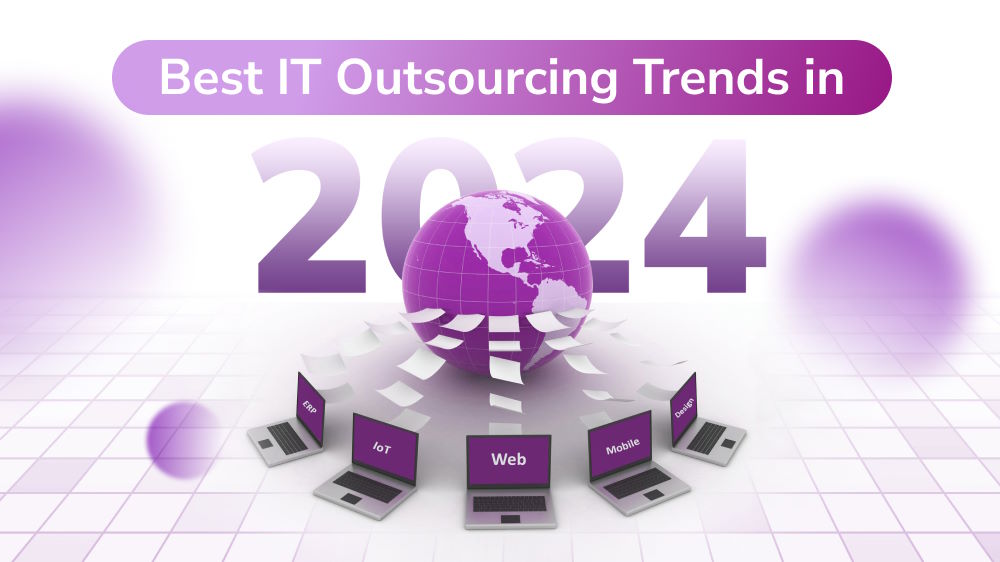
Take the Lead with Offshore Software Product Development - An Executive Guide
This guide helps business leaders and decision-makers navigate the complex yet opportunity-rich landscape of developing and scaling software products through offshore teams.

Content Map
More chaptersIf you are interested in software development, you have probably heard some of these myths.
- Offshore software product development is only for large and rich enterprises.
- Offshore is only cost-effective in the short term. In the long term, it will become more expensive.
- Offshore software development leads to security and product quality concerns, not to mention the difficulty in communication due to the different time zones.
Even though offshoring has been prevalent in the software industry, there still needs to be more clarity surrounding the term. This article aims to provide you with clear and concise information regarding the subject: What it really means, what its real advantages and disadvantages are, services that should be offshored, the best way for you to estimate an offshore project cost, and how to pull it off.
Key Takeaways:
- Offshore software product development is a strategic way for businesses to reduce costs, scale quickly, and tap into global talent. It’s not just for large enterprises. When done right, companies of all sizes can benefit from it.
- There are three main models to choose from: Full project outsourcing, dedicated team, and extended team. For larger-scale needs, an Offshore Development Center (ODC) offers long-term scalability and integration.
- Key benefits of offshoring include cost efficiency, access to specialized skills, and faster time to market. Challenges like miscommunication and time zone differences can be managed with the right tools and planning.
- To succeed, choose the right outsourcing vendor, start with a pilot project, and clearly define your goals. Countries like Vietnam offer an ideal environment for building successful offshore development partnerships.
Offshore Software Product Development Basics

What Does Offshore Software Development Mean?
Offshore software development is the process of using a remote-based development team to develop parts or a complete software product for your home country. It is commonly abbreviated as offshoring or offshore outsourcing.
Outsourcing allows you to choose offshore software development services from a professional vendor or freelancer. While a single freelancer is great for a specific field or aspect of a project, the entire workflow or software development lifecycle often requires certain key roles involving different specialized skills. For example, mobile app development, UI/UX design, or QA testing.
Depending on the project requirements of your project, you can choose offshore, nearshore, or onshore software development services. Each location-based model comes with its own advantages and disadvantages. It helps to have a better picture of the current outsourcing market as well as be aware of the available outsourcing methods in order to make informed decisions.
What Are Different Offshore Software Development Models?
When businesses decide to embrace offshoring, one of the most important strategic decisions they must make is choosing the right engagement model. Your choice will determine how the offshore team integrates with your internal operations, how responsibilities are distributed, and how flexible your SDLC can be. Broadly speaking, there are three common offshore development models for your consideration, and each has its own strengths that make it best suited to different business contexts and goals.
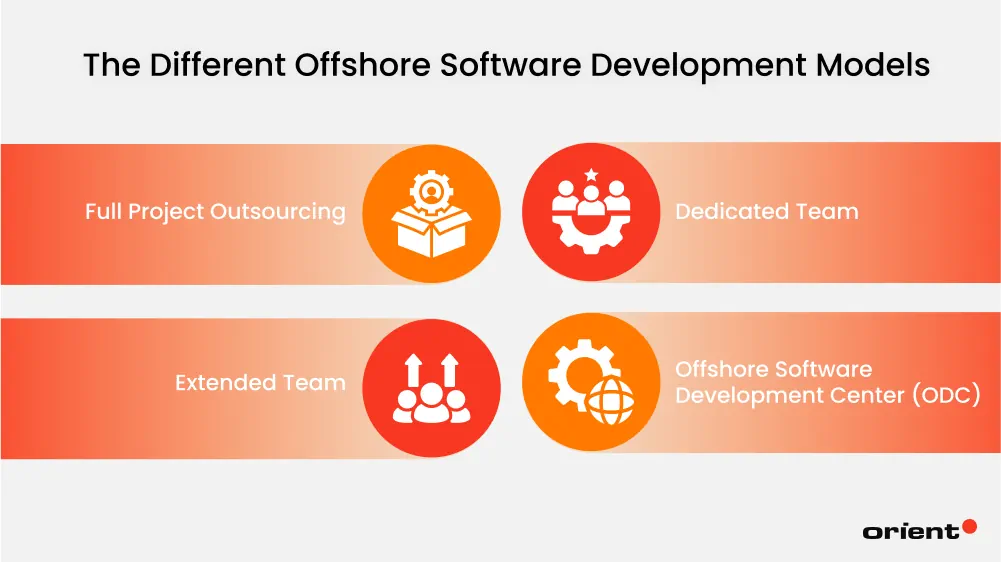
Full Project Outsourcing
This is the most hand-off model when you entrust the entire software product development process to the service provider. This includes everything from project planning and requirements gathering to development, quality assurance, delivery, post-launch maintenance, and support. In this engagement model, the offshore development vendor assumes full responsibility for the project’s outcome, including managing the team, workflow, and delivery timelines.
Full project outsourcing offers maximum convenience and minimal client involvement, and this model is ideal for companies that either lack an internal tech team or want to free up their resources to focus on other strategic initiatives. Nevertheless, it demands a high degree of trust in the vendor’s capabilities, communication, alignment with your business objectives, and other factors like intellectual property and security. It works best for well-scoped projects with clear requirements and timelines.
Dedicated Team
In this model, the offshore partner supplies a team of developers or professionals who work exclusively for you, often in the long term, but they still remain the full-time employees of the outsourcing vendor.
With a dedicated team, you retain control over task assignments, timelines, and priorities while the vendor handles administrative responsibilities like recruitment and HR. A dedicated offshore is effective for companies that need to scale development capacity quickly or run long-term projects with evolving requirements. It offers the flexibility and continuity needed to build long-term knowledge within the team and maintain alignment with your vision.
Extended Team
This model functions more like a collaborative partnership rather than a client-vendor relationship. An extended team includes external developers or specialists provided by the vendor. These augmented professionals work as an extension of your in-house team. They collaborate directly with your internal staff, share the same goals, and follow your workflows.
The biggest advantage is that you don’t have to worry about the overhead of hiring full-time employees. This offshore outsourcing model works for companies that need to augment their workforce with specialized expertise and additional manpower. It is valuable, especially when you already have a solid internal team and technical leadership in place.
Offshore Software Development Center (ODC)
An offshore software development center operates similarly to a dedicated team but on a more structured, strategic, and often larger scale. It encompasses not just software developers but also a full range of supporting roles, including quality assurance engineers, DevOps specialists, project managers, and administrative staff, along with the necessary infrastructure tailored to meet your organization’s specific processes, standards, and goals. In many cases, an ODC functions as a virtual extension of your company, closely mirroring the structure and culture of your in-house operations.
Over time, an ODC can evolve into a captive center, which is fully owned and managed by your company within an offshore location. Business owners may opt for the Build-Operate-Transfer (BOT) model, wherein a trusted offshore service provider sets up and runs the center on your behalf during the initial stages. Once the operation is stable and aligned with your objectives, full ownership, and control are transferred to your organization. This model offers a low-risk pathway to establishing a permanent offshore presence while maintaining long-term strategic flexibility.
What’s the Difference Between Offshore Development and Outsourcing?
Offshoring and software development outsourcing share the same idea of handling parts of the project or the entire development process to a third party. It could be a vendor or a freelancer.
The major difference, however, is the location. When you are outsourcing, it often means you hire a person or team in the same country or the nearby region. In the offshore development model, service providers are located in overseas countries. Your chosen offshore development partner may own a business or continue to outsource the service to local vendors or independent contractors.
Pros and Cons of Offshore Software Development
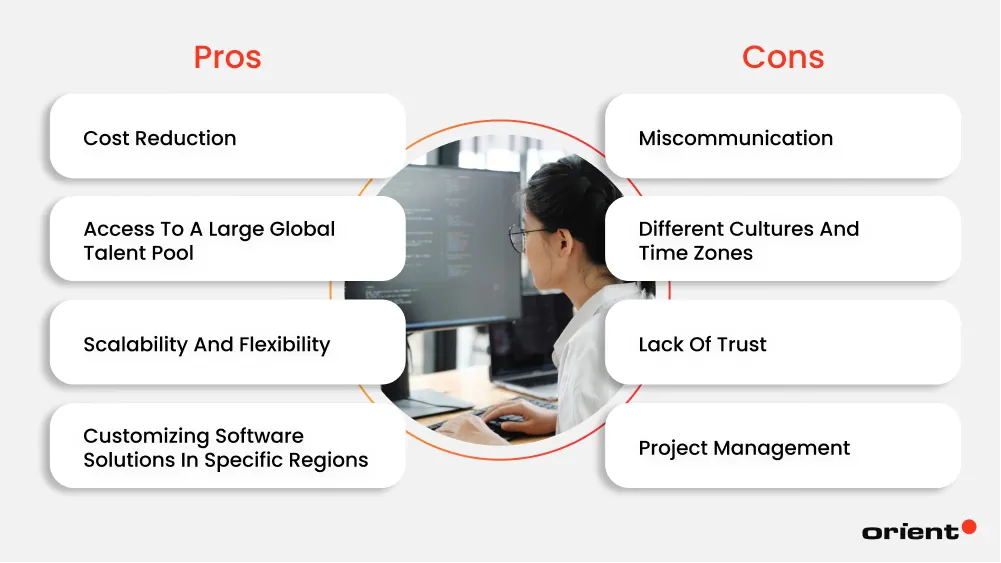
Pros
Offshore outsourcing is prevalent in the software development industry due to its attractive benefits.
Cost Reduction
Cost savings are listed as the top goal for every outsourcing operation in the Deloitte Global Outsourcing Survey for 2020.
A major reason for the prevalence of offshoring is its affordable prices. The average rate of a junior developer in the United States is $105 to $111, while the rate for hiring developers with the same level of expertise from Asia only ranges from $25 to 42$.
In addition, the money spent on lengthy recruitment processes, onboarding, training, maintenance, and welfare can be used elsewhere. Hiring offshore developers typically costs less than maintaining an in-house team, especially in the long term.
With the technical expertise of offshore software development companies, you enjoy the best solutions instead of constantly testing to find one. Again, you can use the costs saved elsewhere while the development process is much more efficient.
Access to a Large Global Talent Pool
One of the many advantages of offshore development is its global reach. Unlike traditional hiring methods, offshore software outsourcing gives you access to a massive international talent pool. Not only is the talent pool large (it is estimated that there are over 25 million software developers worldwide), but it also offers a range of technical skill sets. You have access to some of the best software developers who build web apps, mobile apps, UI/ UX designs, and other kinds of custom software products.
Therefore, working with the right offshore software development company means enjoying meaningful insights and excellent action plans so you can quickly kickstart the project. Moreover, time to market is cut short, so you can quickly gain your market share and work on increasing the revenue.
Scalability and Flexibility
One of the offshore software development benefits cited often is scalability. Scalability is crucial no matter what company or sector. Having the ability to scale resources as needed means the organization has the ability to adjust to changing market conditions or workloads. Besides taking advantage of economies of scale, a scalable business can quickly ramp up production to meet demand.
This is especially helpful for small businesses that are growing fast. The company is given time and space to focus on core, value-driven business activities instead of stretching resources thin to work on tasks or projects that are outside of its core competencies.
Customizing Software Solutions in Specific Regions
Having offshore software developers on board allows you to better customize your software for a specific location. If the offshore team is local, you won’t have to worry about errors in focus, function, content, or translation that are often made by people who don’t know the language and culture of the region.
Cons
Despite its attractive benefits, there are limits to offshore development services. Below is a list of the top concerns.
Miscommunication
Inefficient communication leads to mistakes, delays, and an overall negative impact on the project’s timeline and budget. Miscommunication is especially common when teams work in different time zones.
Therefore, both parties need to establish clear communication channels, points of contact, milestones, and so on. Make sure everyone is looped in on the updates to ensure the entire team is on the same page. Also, the offshore development team should provide its customers with excellent customer service and look for opportunities to collaborate as much as possible.
Different Cultures and Time Zones
There is a high possibility that the offshore development company of your choice is located in a different time zone. Sometimes, the time difference can go up to 10 hours, making it difficult to set up meetings or track the overall processes. This is even more of a challenge when your partners are spread out in various time zones working on various parts of the project.
Therefore, start by being aware of the time zone differences, then set up spreadsheets to keep both companies updated without the need to set up multiple meetings.
Another important thing to keep in mind is cultural differences. This point could easily come as an afterthought. However, without proper research into your offshore development company culture, you might come off as rude and disrespectful. Be prepared and look into your partner’s cultural norms to create a favorable first impression.
Lack of Trust
Many firms are reluctant when it comes to outsourcing software development companies due to trust issues. It is easy for the mind to wander to the worst scenarios: missing deadlines, poor deliverable quality, leak of confidential information, and the list goes on. This is completely normal. Luckily, there are numerous ways to build trust.
You can start by going through the client’s testimony of the company, then establish clear timelines and milestones, conduct regular reviews, and set up communication protocols to address issues as soon as possible.
Project Management
Offshore software development outsourcing does pose challenges to project management. Even so, as long as you work out a clear goal, set clear expectations, and have effective communication, project management shouldn’t be a problem. If you are still wary of the subject, have your project manager check out our detailed guide on project management.
Functions That Should Be Outsourced to an Offshore Software Development Vendor
Being aware of the pros and cons of certain services allows you to step into the journey with a lot more confidence. We want to further boost this confidence by helping you determine the top services for hiring offshore developers. Outsourcing software development company is the answer if you are looking for:
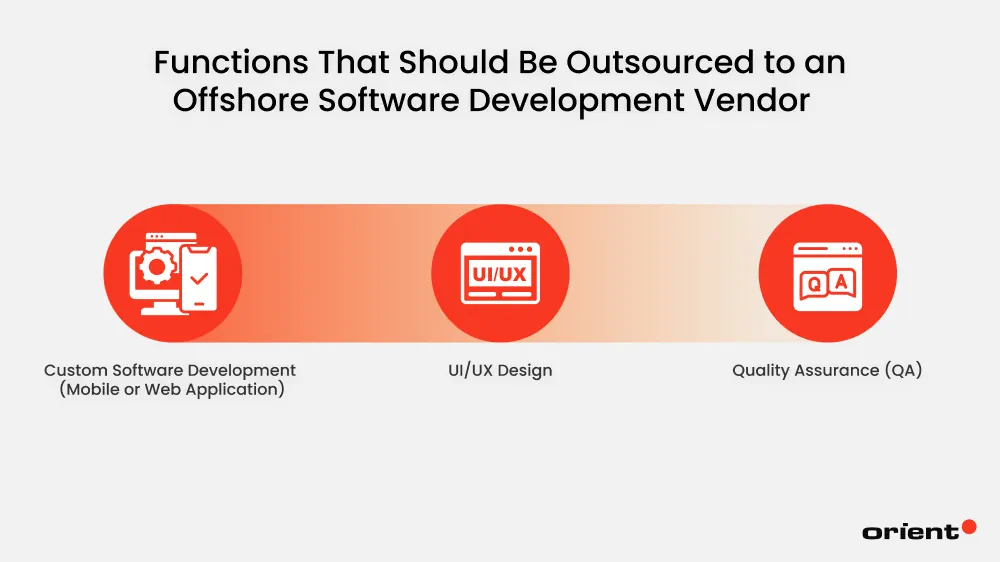
Custom Software Development (Mobile or Web Application)
Gone are the days of constantly looking for the newest and hottest technology in mobile or web app development. Your offshore software development team knows the newest cutting-edge technology and the most sought-after web functions to increase your online presence.
UI/UX Design
Don’t overlook the user interface (UI) and user experience (UX) when you outsource software development. With the help of professional designers, all you need to do is communicate your vision and expectation of a user-friendly interface and smooth UX.
Quality Assurance (QA)
To make sure your software works as intended, you need to have an experienced QA team examine it. First impressions are everything. Before launching your product, have a third party go over the project to fix bugs and point out weaknesses, and your product is guaranteed to impress its target audience.
Estimating Offshore Software Development Costs
What is the exact cost of an offshore software development project? Every project is unique, so it is difficult to provide an exact number. Even with a given range, it would still be difficult to estimate the budget without knowing the specifics.
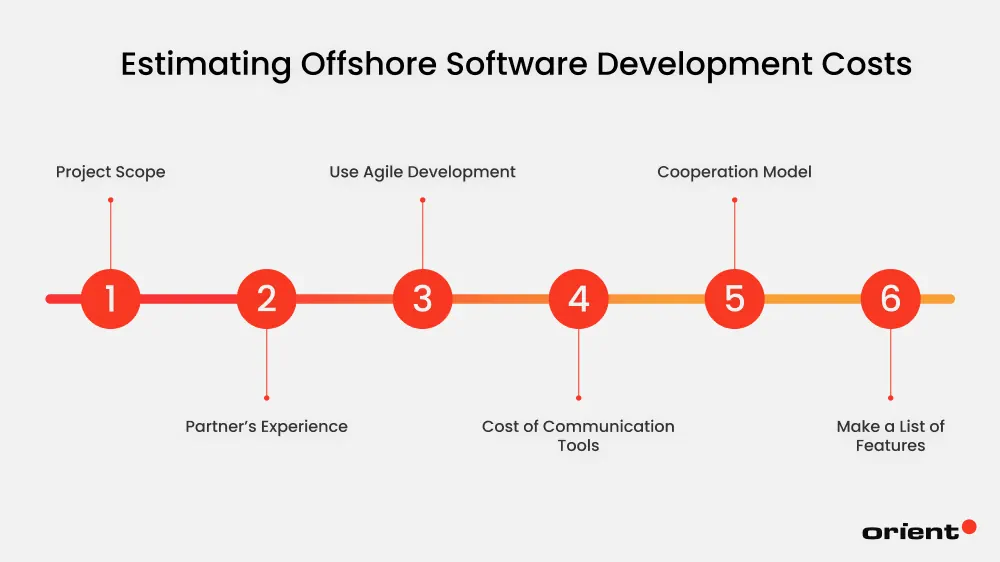
However, there are some criteria that you can refer to when you need to estimate the cost of an offshore software development model.
- Project Scope: What is your project scope? What are the software’s key features and functionalities? Answering these two questions is crucial for you to work out the project timeline and cost estimation.
- Partner’s Experience: You should always look into your partner’s expertise and experiences. However, do expect a higher rate when you work with more experienced companies.
- Use Agile Development: Using agile development methods can help you get a better idea of how much offshore software development costs are going to be. Basically, Agile development breaks down your project into smaller, easier-to-manage tasks and breaks them down into short sprints.
- Cost of Communication Tools: Communication is key. Therefore, if necessary, consider investing in video conference tools, project management tools, collaboration tools, or instant messaging tools.
- Cooperation Model: The cost will vary depending on the model you select—time and material, fixed fee, or dedicated team. Keep in mind that not all outsourcing firms provide all three, so be sure to check that as well.
- Make a List of Features: Work together with your team to come up with a list of “must have” and “nice to have” features for your software. You will have a clearer view of what the MVP looks like and how much it costs. You can also look for projects of a similar nature for cost estimation.
How to Choose the Right Offshore Software Development Partner
Whether it is offshore, onshore, or nearshore software development, the right vendor is always the make-or-break factor for the entire endeavor. With thousands of service providers available and different countries to outsource to, business owners need a clear strategy that ensures they take crucial steps to find the perfect fit, and it requires more than comparing hourly rates.
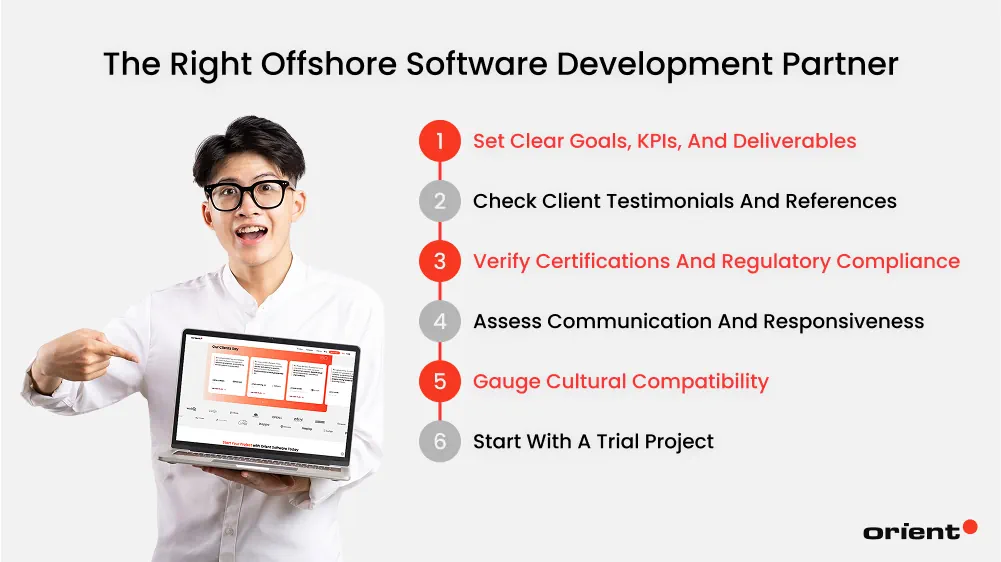
Here’s a brief yet detailed checklist to help you navigate the selection process:
Set Clear Goals, KPIs, and Deliverables
Before searching for an offshore software development outsourcing company, you need to establish concrete business objectives and break them down into measurable parameters. These, including project scope, priorities, milestones, code quality standards, bug thresholds, and resolution timelines, are essential for assessment and decision-making.
Check Client Testimonials and References
Most offshore companies showcase glowing testimonials on their websites, but do not stop there. Ask for references and then speak directly with existing or past clients. Honest feedback from real clients offers a clearer picture of the vendor’s professionalism, reliability, and communication practices than a polished marketing pitch.
Verify Certifications and Regulatory Compliance
Equally important is ensuring that your offshore partner complies with necessary certifications and legal regulations. Depending on your industry or geography, this includes ISO 27001 for information security, GDPR (General Data Protection Regulation) for European data privacy, and HIPAA for U.S. healthcare-related projects. Make sure to ask about internal security protocols, access control mechanisms, and data confidentiality clauses in their contracts.
Assess Communication and Responsiveness
A reliable partner should demonstrate prompt and clear communication even during early discussions. You should evaluate:
- Language fluency (especially English)
- Responsiveness to emails or messages
- Availability in overlapping work hours
- Willingness to participate in virtual meetings and demos
- Transparent communication - which is crucial for building trust and reducing the risk of misunderstandings.
Gauge Cultural Compatibility
Cultural alignment might seem secondary, but it significantly affects collaboration. Consider whether the offshore team demonstrates empathy, patience, adaptability, and initiative. Companies with a global clientele often have cross-cultural training and diverse teams that make collaboration smoother.
Start with a Trial Project
Before fully committing, you should test the waters with a pilot project - a small-scale, preliminary initiative carried out to test the feasibility, effectiveness, and potential risks of a larger project or long-term engagement. This allows you to evaluate the team’s capabilities, workflow, and collaboration style without a long-term obligation. It also helps uncover potential friction points early.

If you’re still not sure where to start with offshore outsourcing, why not start in Vietnam? It is a great place to start. Due to its stable economy, the government’s unwavering backing for entrepreneurship, and its proficient English speakers, Vietnam is seen as the promised land for offshore software engineering.
Orient Software is one of Vietnam’s leading software development services companies. The team possesses extensive experience and prides itself on being one of the top offshore development centers in the country. Contact us today to build your dream software while enjoying the numerous merits of offshore outsourcing.




